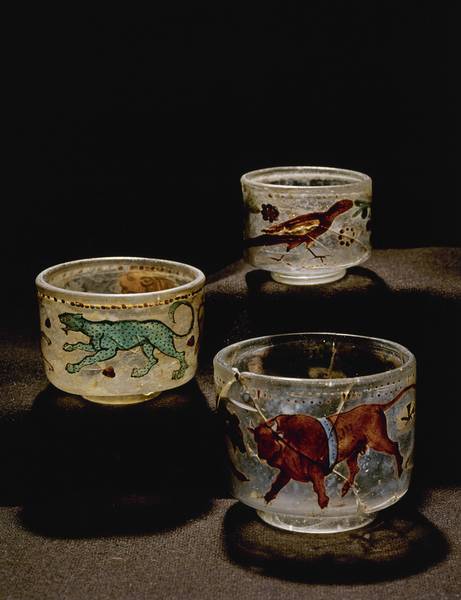This is a subway-style map of Roman Roads c. 125 CE created by Sasha Trubetskoy. Trubetskoy has created additional maps focusing on specific parts of the Roman empire such as Gaul and Britain as well.

Just another nerd.
This is a subway-style map of Roman Roads c. 125 CE created by Sasha Trubetskoy. Trubetskoy has created additional maps focusing on specific parts of the Roman empire such as Gaul and Britain as well.

This animation of the Mount Vesuvius eruption was prepared for a 2009 exhibit at Melbourne Museum.

Poena cullei (from Latin ‘penalty of the sack’) under Roman law was a type of death penalty imposed on a subject who had been found guilty of parricide. The punishment consisted of being sewn up in a leather sack, with an assortment of live animals including a dog, snake, monkey, and a chicken or rooster, and then being thrown into water.
The punishment may have varied widely in its frequency and precise form during the Roman period. For example, the earliest fully documented case is from ca. 100 BCE, although scholars think the punishment may have developed about a century earlier. Inclusion of live animals in the sack is only documented from Early Imperial times, and at the beginning, only snakes were mentioned. At the time of Emperor Hadrian (2nd century CE), the most well known form of the punishment was documented, where a cock, a dog, a monkey and a viper were inserted in the sack. At the time of Hadrian poena cullei was made into an optional form of punishment for parricides (the alternative was being thrown to the beasts in the arena).
During the 3rd century CE up to the accession of Emperor Constantine, poena cullei fell out of use; Constantine revived it, now with only serpents to be added in the sack. Well over 200 years later, Emperor Justinian reinstituted the punishment with the four animals, and poena cullei remained the statutory penalty for parricides within Byzantine law for the next 400 years, when it was replaced with being burned alive. Poena cullei gained a revival of sorts in late medieval and early modern Germany, with late cases of being drowned in a sack along with live animals being documented from Saxony in the first half of the 18th century.
These Roman circus cups were created sometime in the 2nd or 3rd century AD and then imported into Denmark, presumably by wealthy families. They are on display in The National Museum of Denmark, and were found as burial goods in graves founds on the Stevns peninsula.

Lupercalia was an annual ritual practised in Rome possibly from before The Eternal City’s founding all the way until the 4th century CE when it was banned by Christian authorities.
Lupercalia was a very ancient, possibly pre-Roman pastoral annual festival, observed in the city of Rome, each year, on February 15, to avert evil spirits and purify the city, releasing health and fertility. Lupercalia subsumed Februa, an earlier-origin spring cleansing ritual held on the same date, which gives the month of February (Februarius) its name.
. . .
The rites were confined to the Lupercal cave, the Palatine Hill, and the Forum, all of which were central locations in Rome’s foundation myth. Near the cave stood a sanctuary of Rumina, goddess of breastfeeding; and the wild fig-tree (Ficus Ruminalis) to which Romulus and Remus were brought by the divine intervention of the river-god Tiberinus; some Roman sources name the wild fig tree caprificus, literally “goat fig”. Like the cultivated fig, its fruit is pendulous, and the tree exudes a milky sap if cut, which makes it a good candidate for a cult of breastfeeding.
A male goat (or goats) and a dog were sacrificed by one or another of the Luperci, under the supervision of the Flamen dialis, Jupiter’s chief priest: and an offering of salt mealcakes prepared by the Vestal Virgins. After the sacrifice at the Lupercal, two Luperci approached its altar. Their foreheads were anointed with blood from the sacrificial knife, then wiped clean with wool soaked in milk, after which they were expected to smile and/or laugh.
The sacrificial feast followed, after which the Luperci cut and carried thongs (known as februa) of the newly flayed goatskin, and ran naked (only in loincloths) along the old Palatine boundary, in an anticlockwise direction around the hill. In Plutarch’s description of the Lupercalia, written during the early Empire,
…many of the noble youths and of the magistrates run up and down through the city naked, for sport and laughter striking those they meet with shaggy thongs. And many women of rank also purposely get in their way, and like children at school present their hands to be struck, believing that the pregnant will thus be helped in delivery, and the barren to pregnancy.
The Luperci completed their circuit of the Palatine, then returned to the Lupercal cave. Descriptions of the Lupercalia festival of 44 BC attest to its continuity as Caesar used it to stage a ceremony in which Mark Antony presented him a royal crown, which he then refused.